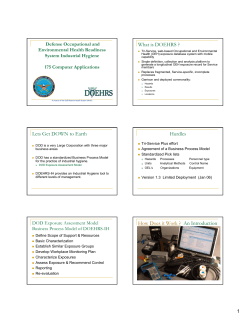
Occupational Therapy for Children American Occupational Therapy Association Fact Sheet
American Occupational Therapy Association Fact Sheet Occupational Therapy for Children Birth to 3 Years of Age Occupational therapists and occupational therapy assistants provide services to infants and toddlers birth to 3 years of age who have or are at risk for developmental delays or disabilities. Occupational therapy practitioners, as part of the multidisciplinary team, provide services to young children and their families in a variety of settings, including hospitals, early intervention programs, private clinics, child care settings, schools, and at home. Occupational therapy is concerned with a child’s ability to participate in daily life activities or “occupations.” Occupational therapists and occupational therapy assistants use their unique expertise to help children with social-emotional, physical, cognitive, communication, and adaptive behavior challenges. Through an understanding of the impact of disability, illness, and impairment on a child’s development, play, ability to learn new skills, and overall occupational performance, occupational therapists design interventions that promote healthy development, establish needed skills, and/or modify environments, all in support of participation in daily activities. Occupational therapy practitioners also play a key role in educating parents, caregivers and program staff about child development, and they provide information about disability and diverse learning needs. Occupational therapists collaborate with parents and other members of the team to ■ identify and conduct appropriate assessment; ■ plan and implement relevant intervention strategies and developmentally appropriate activities; ■ reduce environmental barriers that limit a child’s participation in family, learning, and communitybased activities; ■ identify needed assistive technology devices and supports; and ■ prepare children and their families for transition to preschool. Occupational therapy is an important service for infants and toddlers with a variety of conditions, including premature birth, low-birth weight, congenital anomalies, neurological disorders, sensory processing difficulties, challenging behavior, neuromuscular disease, prenatal drug exposure, and autism. Services address feeding skills, sensory integration, motor development, environmental exploration, play skills, adaptive behavior, and interactions between the child and caregiver. Occupational therapists work with other members of the team, including physicians, nurses, speech-language pathologists, psychologists, physical therapists, teachers and parents to identify the needs of infants and toddlers and their families. They target desired outcomes and determine the services, supports, and modifications or accommodations needed to achieve those outcomes. When occupational therapy expertise is needed to help the child and family meet their desired goals, services should be included in the child’s program. Occupational therapy services for infants and toddlers are available through a variety of agencies and programs, including hospitals, Early Head Start programs, home health agencies, and early intervention programs under Part C of the Individuals with Disabilities Education Act (IDEA). ■ Developed for AOTA by Leslie Jackson, MEd, OTR, and Julie Bissell, MA, OTR/L, ATP References American Occupational Therapy Association. (2004). Occupational therapy services in early intervention and school-based programs. American Journal of Occupational Therapy, 58, 681–685. American Occupational Therapy Association. (2002). Occupational therapy practice framework: Domain and process. American Journal of Occupational Therapy, 56, 609-639. American Occupational Therapy Association (1999). Occupational therapy services for children and youth under the Individuals with Disabilities Education Act (2nd ed.). Bethesda, MD: Author. The American Occupational Therapy Association 4720 Montgomery Lane Bethesda, MD 20814-3425 301-652-AOTA (2682) www.aota.org Occupational Therapy: Skills for the Job of Living Copyright 2006 American Occupational Therapy Association. All rights reserved. This material may be printed and distributed without prior written consent.
© Copyright 2025





















